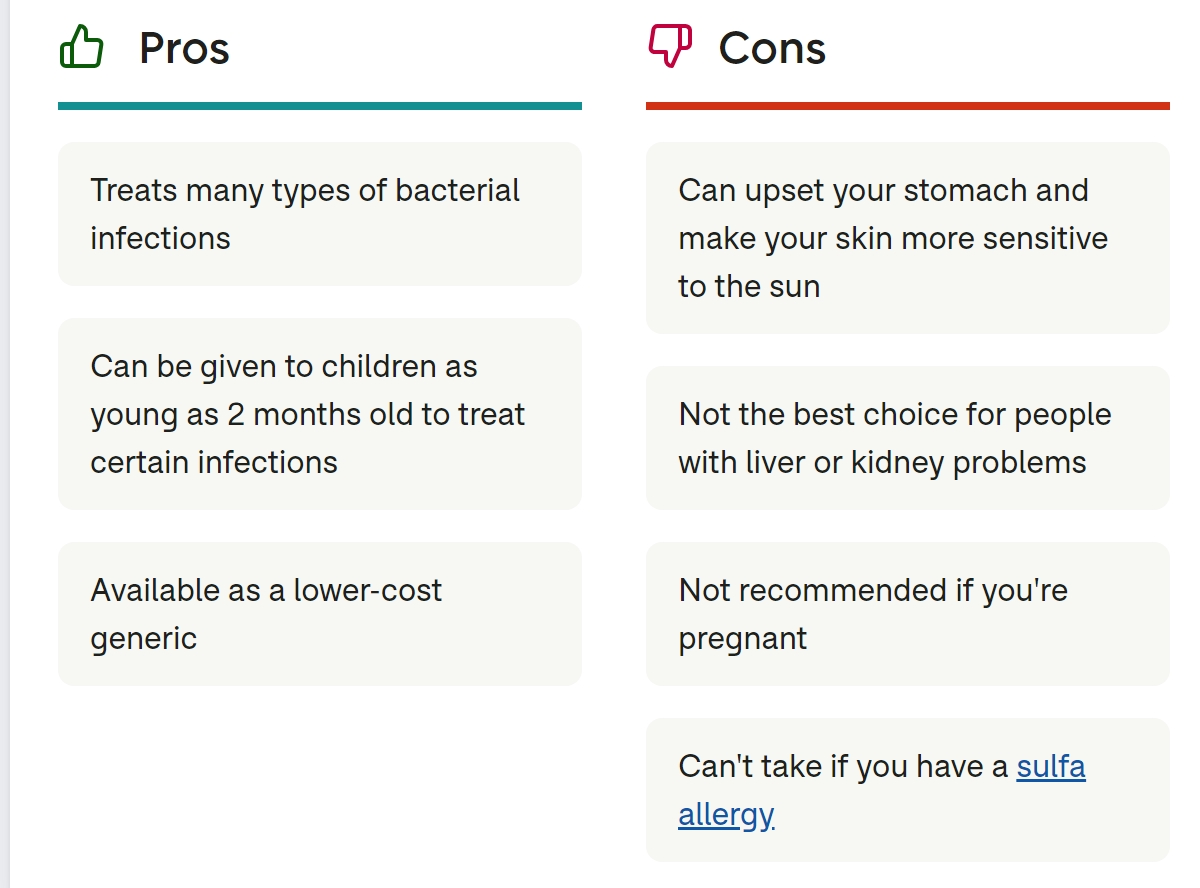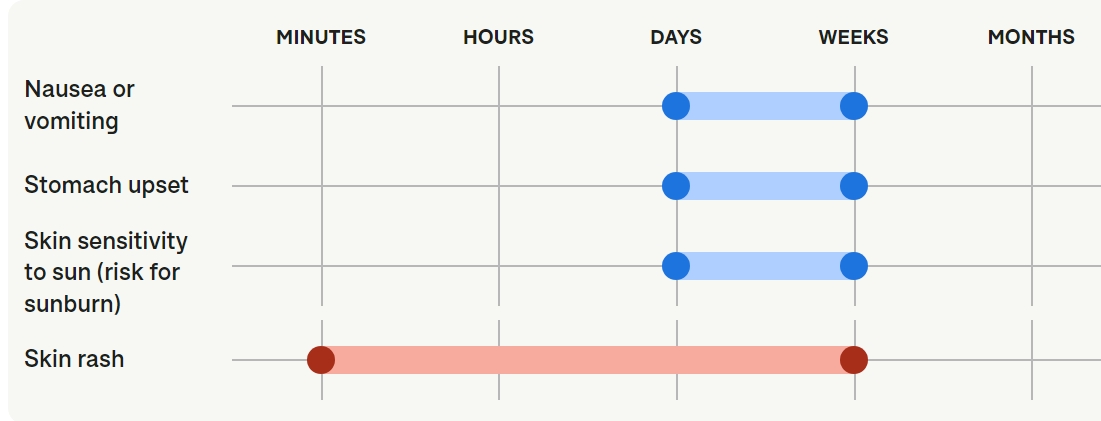Overview
Sulfamethoxazole/trimethoprim (sometimes known as SMZ/TMP) is a combination medication containing an antifolate and sulfa antibiotic. It's used to treat different types of infections, such as urinary tract infections (UTIs), ear infections, and lung infections. This antibiotic has two different brand names, Bactrim and Septra, and it's also available as a lower-cost generic. It's a tablet that's taken by mouth, typically twice daily for most types of infections. This antibiotic also comes as a suspension under the brand name Sulfatrim for people who can't swallow tablets and as an injection for people in the hospital. Common side effects include nausea, diarrhea, and rash.
What is Sulfamethoxazole trimethoprim used for?
- Urinary tract infection (UTI)
- Lower respiratory tract infection (e.g., Pneumocystis pneumonia, infections related to bronchitis)
- Diarrhea caused by Shigella (shigellosis)
- Travelers' diarrhea - tablet or liquid only
- Ear infections - tablet or liquid only
How Sulfamethoxazole trimethoprim works
Sulfamethoxazole/trimethoprim is a combination of two antibiotics, sulfamethoxazole (a sulfonamide) and trimethoprim (antifolate). They work together to stop bacteria from being able to make folic acid, a nutrient that's important for bacterial growth and survival. By stopping bacteria from making folic acid, sulfamethoxazole/trimethoprim kills the bacteria.
When does Sulfamethoxazole trimethoprim start working?
Time passed since treatment started:

- Take sulfamethoxazole trimethoprim exactly as prescribed. Make sure to finish your antibiotic treatment, even if you're feeling better. Stopping the antibiotic earlier than prescribed can make your infection come back and become harder to treat.
- You can take sulfamethoxazole trimethoprim with or without food. Taking it with food might help lessen nausea and stomach upset from the medication.
- Make sure to drink enough fluids while you're taking sulfamethoxazole trimethoprim. Staying hydrated can help lower your risk for possible kidney problems with this antibiotic.
- Get medical help right away if you have watery or bloody diarrhea, fever, fatigue, or stomach cramps at any time during treatment or after stopping sulfamethoxazole/trimethoprim. These could be signs of a type of infectious diarrhea called Clostridiodes difficile (C. diff)-related diarrhea, which should be treated as soon as possible.
- Ask a healthcare professional (HCP) whether it's safe and appropriate for you to take a probiotic with sulfamethoxazole trimethoprim. Probiotics might help lessen the risk of a rare, but serious C. diff infection that's possible with antibiotic treatment. Separate the probiotic from sulfamethoxazole trimethoprim by at least 2 hours to prevent the antibiotic from killing the "good" bacteria in the probiotic.
- Be sure to tell your prescriber and pharmacist about all of the medications and supplements that you're taking. Sulfamethoxazole/trimethoprim interacts with many medications, such as warfarin (Coumadin), ACE inhibitors, ARBs, and leucovorin, among others. Your healthcare team can check for drug interactions and make sure all your medications are safe to take together.
- Although rare, your blood sugar levels might drop while you're taking sulfamethoxazole trimethoprim. This might be more likely if you have liver or kidney problems or poor nutrition. If you have diabetes and you're taking diabetes medications, ask your HCP whether you should check your blood sugar more often while you're taking this antibiotic.
- Sulfamethoxazole trimethoprim isn't recommended during pregnancy. This antibiotic can get in your body's way of processing folic acid, a nutrient that's important to a baby's development in the womb. Make sure to tell your healthcare team if you're pregnant; they'll most likely prescribe a different antibiotic for you.
- In general, it's okay to breastfeed while you're taking sulfamethoxazole trimethoprim if your baby is older than 2 months and born full-term. But it isn't recommended to nurse while you're taking this antibiotic if your baby was born premature, is sick, or has jaundice. To be safe, ask your healthcare team whether it's safe for you to breastfeed your baby while you're taking this antibiotic.
What are the risks and warnings for Sulfamethoxazole/trimethoprim?
Sulfamethoxazole/trimethoprim can cause some serious health issues. This risk may be even higher for certain groups. If this worries you, talk to your doctor or pharmacist about other options.
Not for use during pregnancy
Sulfamethoxazole/trimethoprim isn't recommended during pregnancy because there's a risk that the antibiotic can cause severe developmental harm to an unborn baby. Let your prescriber know if you're pregnant or thinking of becoming pregnant before starting this antibiotic. Also contact your prescriber right away if you find out that you're pregnant while you're taking sulfamethoxazole/trimethoprim. Your prescriber can discuss treatment options that are safer for you.
Severe allergic reactions and skin reactions
- Risk factors: Allergy to sulfa
Severe allergic reactions to sulfamethoxazole/trimethoprim are possible, including life-threatening reactions, like facial swelling and anaphylaxis. Although rare, this antibiotic can also cause serious skin reactions, such as Stevens-Johnson syndrome (SJS) and drug reaction with eosinophilia and systemic symptoms (DRESS syndrome).
Let your prescriber know if you have an allergy to antibiotics or medications, especially any sulfa drugs, to make sure this antibiotic is safe for you. Stop taking sulfamethoxazole/trimethoprim and get medical attention right away if you notice any hives, rash, blisters, skin reddening, skin peeling, swelling of the lips or tongue, or trouble breathing.
Low platelet counts and risk for bleeding
- Risk factors: Taking sulfamethoxazole/trimethoprim together with medications that raise your bleeding risk
Sulfamethoxazole/trimethoprim can lower your platelet count (thrombocytopenia). Having a low platelet count can put you at risk for serious bleeding. Your risk is higher if you're taking this antibiotic with other medications that also raise your bleeding risk, such as aspirin or warfarin (Coumadin). Typically, platelet counts go back to usual within a week after stopping the antibiotic.
Seek medical help right away if you have any unusual bleeding; bleeding that lasts for a long time; trouble stopping bleeds; easy bruising; or blood in your vomit, urine, or stool. Speak to a healthcare professional (HCP) if you have concerns.
Diarrhea from Clostridioides difficile infection
Sulfamethoxazole/trimethoprim can raise your risk of getting infected with a bacteria called Clostridioides difficile (C. diff). Antibiotics change the amount of normal bacteria in your stomach and intestines. This can cause C. diff to overgrow in your gut and lead to an infection. C. diff infection can cause severe diarrhea.
It's important to recognize the difference between diarrhea as a side effect of sulfamethoxazole/trimethoprim and C. diff-related diarrhea. This type of infectious diarrhea can cause rapid heart rate, fever, nausea, foul-smelling diarrhea, and frequent bowel movements (even up to 15 times per day). It's a medical emergency, so get help right away if you have any symptoms of a C. diff infection. You'll need to get tested for C. diff infection and get treatment.
Low sodium levels and high potassium levels
- Risk factors: Taking high doses of sulfamethoxazole/trimethoprim | Kidney problems
Sulfamethoxazole/trimethoprim, especially at high dosages, can raise your potassium levels and lower your sodium levels. Contact an HCP right away if you experience weakness, tingling or numbness, headache, confusion, trouble concentrating, or memory problems.
Blood cell-related problems
- Risk factors: Genetic condition called glucose-6 phosphate dehydrogenase (G6PD) deficiency | Older adult | Regularly drink alcohol | Kidney problems | Liver problems | Poor nutrition
Taking sulfamethoxazole/trimethoprim can lead to some blood-cell related problems in certain people. For example, people who have certain genetic conditions are at risk of having their red blood cells damaged and broken down when they take this antibiotic.
Taking sulfamethoxazole/trimethoprim can also sometimes make it more difficult for your body to absorb an important vitamin called folic acid. This can sometimes lead to low folic acid levels, which can affect how well your body can make blood cells. Low folic acid levels might be more likely if you're an older adult, if you regularly drink large amounts of alcohol, or if you have kidney or liver problems.
Problems with processing phenylalanine - for people with phenylketonuria (PKU) only
People with a rare genetic condition called phenylketonuria should be sure to follow a low-protein diet while they're taking sulfamethoxazole/trimethoprim. This genetic condition happens when the body has trouble processing a nutrient called phenylalanine. And sulfamethoxazole/trimethoprim can make it even harder for the body to break down this nutrient. Following a proper diet seems to help prevent you from having any noticeable PKU problems.
Strengths
Tablet
- 400mg/80mg
- 800mg/160mg
Dosages
- Urinary tract infections (UTI) or shigellosis
- Adults: The typical dose is 800 mg/160 mg of sulfamethoxazole trimethoprim by mouth every 12 hours. The antibiotic is taken for 10 to 14 days for UTI and 5 days for shigellosis.
- Children age 2 months and older only: The prescriber will calculate the dose based on your child's body weight. The typical dose is 20 mg/kg of sulfamethoxazole and 4 mg/kg of trimethoprim by mouth every 12 hours. It's taken for 10 days for UTI and 5 days for shigellosis.
- Ear infections
- Children age 2 months and older: The prescriber will calculate the dose based on your child's body weight. The typical dose is 20 mg/kg of sulfamethoxazole and 4 mg/kg of trimethoprim by mouth every 12 hours for 10 days.
- Infections related to bronchitis
- Adults only: The typical dose is 800 mg/160 mg sulfamethoxazole trimethoprim by mouth every 12 hours for 14 days.
- Pneumocystis pneumonia
- Prevention
- Adults: The typical dose is 800 mg/160 mg of sulfamethoxazole trimethoprim by mouth once per day.
- Children age 2 months and older: The prescriber will calculate the dose based on your child's body weight and height. In general, the typical dose is 200 mg/40 mg or 400 mg/80 mg of sulfamethoxazole/trimethoprim by mouth every 12 hours.
- Treatment
- Adults and children age 2 months and older: The prescriber will calculate your dose based on your body weight. The typical dose is 75 mg/kg to 100 mg/kg of sulfamethoxazole and 15 mg/kg to 20 of mg/kg trimethoprim by mouth per day. The daily dose is divided into equal doses that are taken every 6 hours. Treatment typically lasts for 2 to 3 weeks.
- Prevention
- Travelers' diarrhea
- Adults only: The typical dose is 800 mg/160 mg sulfamethoxazole trimethoprim by mouth every 12 hours for 5 days.
Your dose might differ if you have kidney problems.
Sulfamethoxazole trimethoprim is also available as an injection that's infused through the veins by a healthcare professional (HCP) in a hospital setting.
Read Related Articles
Interactions
Sulfamethoxazole/trimethoprim can interact with various medications or supplements. It is crucial to inform your doctor and pharmacist about all other medications or supplements you are taking, including prescription and over-the-counter drugs, vitamins, and dietary or herbal supplements. The following list does not encompass all potential drug interactions with Sulfamethoxazole trimethoprim. Be aware that only the generic names of the medications are mentioned below.
Using this medicine with any of the following medicines is not recommended. Your doctor may decide not to treat you with this medication or change some of the other medicines you take.
- Dofetilide
- Levomethadyl
- Methenamine
Using this medicine with any of the following medicines is usually not recommended, but may be required in some cases. If both medicines are prescribed together, your doctor may change the dose or how often you use one or both of the medicines.
- Acecainide
- Acenocoumarol
- Ajmaline
- Amiloride
- Amiodarone
- Amitriptyline
- Amoxapine
- Aprindine
- Arsenic Trioxide
- Astemizole
- Azathioprine
- Azilsartan
- Azilsartan Medoxomil
- Azimilide
- Benazepril
- Bretylium
- Candesartan Cilexetil
- Captopril
- Ceritinib
- Chloral Hydrate
- Chloroquine
- Chlorpromazine
- Cholera Vaccine, Live
- Clarithromycin
- Desipramine
- Dibenzepin
- Digoxin
- Disopyramide
- Dolasetron
- Doxepin
- Dronedarone
- Droperidol
- Enalapril
- Enalaprilat
- Enflurane
- Eplerenone
- Eprosartan
- Erythromycin
- Flecainide
- Fluconazole
- Fluoxetine
- Foscarnet
- Fosinopril
- Gemifloxacin
- Halofantrine
- Haloperidol
- Halothane
- Hydroquinidine
- Ibutilide
- Imipramine
- Irbesartan
- Isoflurane
- Isradipine
- Leucovorin
- Lidoflazine
- Lisinopril
- Lorcainide
- Losartan
- Mefloquine
- Mercaptopurine
- Methotrexate
- Moexipril
- Nortriptyline
- Octreotide
- Olmesartan Medoxomil
- Pentamidine
- Perindopril
- Pirmenol
- Porfimer
- Prajmaline
- Probucol
- Procainamide
- Prochlorperazine
- Propafenone
- Pyrimethamine
- Quinapril
- Quinidine
- Ramipril
- Risperidone
- Sapropterin
- Sematilide
- Sertindole
- Sotalol
- Spiramycin
- Spironolactone
- Sultopride
- Tedisamil
- Telithromycin
- Telmisartan
- Trandolapril
- Triamterene
- Trifluoperazine
- Trimipramine
- Valsartan
- Warfarin
- Zofenopril
- Zotepine
Using this medicine with any of the following medicines may cause an increased risk of certain side effects, but using both drugs may be the best treatment for you. If both medicines are prescribed together, your doctor may change the dose or how often you use one or both of the medicines.
- Acetohexamide
- Amantadine
- Aminolevulinic Acid
- Anisindione
- Didanosine
- Fosphenytoin
- Phenytoin
- Repaglinide
- Rifabutin
- Rosiglitazone
- Tolbutamide
Side-effects
The following side effects may get better over time as your body gets used to the medication. Let your healthcare provider know immediately if you continue to experience these symptoms or if they worsen over time.
Common Side Effects
- Nausea
- Vomiting
- Diarrhea
- Loss of appetite
- Rash
- Hives
- Skin sensitivity to sun or light
Other Side Effects
- Muscle pain
- Joint pain
- Fatigue
- Weakness
- Trouble falling asleep
- Changes to blood sugar levels
Serious Side Effects
Contact your healthcare provider immediately if you experience any of the following.
- Serious allergic reaction or skin reaction: hives, rash, blisters, skin reddening, swelling of the lips or tongue, difficulty breathing
- Infectious diarrhea (C. difficile-related diarrhea): rapid heart rate, fever, nausea, foul-smelling diarrhea, frequent bowel movements (even up to 15 times per day)
- High potassium levels: nausea, muscle cramps or weakness
- Low sodium levels: nausea, fatigue, headache, confusion, hallucinations (seeing things that aren't real), seizure, unconsciousness
- Kidney problems: urinating less often than usual; swelling in your feet, ankles, or hands; unexplained weight gain
When do Sulfamethoxazole/trimethoprim possible side effects begin and end?
Time passed since treatment started:
The following side effects have also been reported
Along with its needed effects, a medicine may cause some unwanted effects. Although not all of these side effects may occur, if they do occur they may need medical attention.
Check with your doctor immediately if any of the following side effects occur:
More common
- Black, tarry stools
- Blistering, peeling, or loosening of the skin
- Changes in skin color
- Chest pain or tightness
- Chills
- Cough or hoarseness
- Dark urine
- Diarrhea
- Dizziness
- Fever
- General feeling of tiredness or weakness
- Headache
- Itching, skin rash
- Joint or muscle pain
- Light-colored stools
- Loss of appetite
- Lower back or side pain
- Nausea
- Pain, tenderness, or swelling of the foot or leg
- Painful or difficult urination
- Pale skin
- Red skin lesions, often with a purple center
- Red, irritated eyes
- Sore throat
- Sores, ulcers, or white spots in the mouth or on the lips
- Stomach pain
- Swollen or painful glands
- Trouble breathing
- Unpleasant breath odor
- Unusual bleeding or bruising
- Vomiting of blood
- Yellow eyes or skin
Incidence not known
- Back, leg, or stomach pains
- Bleeding gums
- Blindness or vision changes
- Bloating
- Blood in the urine or stools
- Bluish-colored lips, fingernails, or palms
- Burning, crawling, itching, numbness, painful, prickling, "pins and needles", or tingling feelings
- Burning of the face or mouth
- Cloudy urine
- Confusion
- Constipation
- Continuing ringing or buzzing or other unexplained noise in the ears
- Cracks in the skin
- Decreased frequency or amount of urine
- Difficulty with swallowing
- Fainting spells
- General body swelling
- General feeling of discomfort or illness
- Hair loss
- Hearing loss
- Hives
- Increased thirst
- Indigestion
- Irregular heartbeat
- Large, flat, blue, or purplish patches in the skin
- Large, hive-like swelling on the face, eyelids, lips, tongue, throat, hands, legs, feet, or sex organs
- Loss of heat from the body
- Muscle or joint pain
- Nosebleeds
- Not able to pass urine
- Numbness or tingling in the hands, feet, or lips
- Pain or burning while urinating
- Pinpoint red spots on the skin
- Puffiness or swelling of the eyelids or around the eyes, face, lips, or tongue
- Raised red swellings on the skin, the buttocks, legs, or ankles
- Redness of the white part of the eyes
- Redness, swelling, or soreness of the tongue
- Seizures
- Soreness of the muscles
- Stiff neck or back
- Stomach tenderness
- Swelling of the face, hands, legs, and feet
- Unsteadiness, trembling, or other problems with muscle control or coordination
- Weakness in the hands or feet
- Weakness or heaviness of the legs
- Weight gain or loss
Some side effects may occur that usually do not need medical attention. These side effects may go away during treatment as your body adjusts to the medicine. Also, your health care professional may be able to tell you about ways to prevent or reduce some of these side effects. Check with your health care professional if any of the following side effects continue or are bothersome or if you have any questions about them:
More common
- Passing of gas
Incidence not known
- Discouragement
- Feeling of constant movement of self or surroundings
- Feeling sad or empty
- Increased sensitivity of the skin to sunlight
- Lack of feeling or emotion
- Loss of interest or pleasure
- Nervousness
- Redness or other discoloration of the skin
- Seeing, hearing, or feeling things that are not there
- Sensation of spinning
- Severe sunburn
- Trouble concentrating
- Trouble sleeping
- Uncaring
- Weight loss
Common Concerns
Feedback from Our Clients
Explore feedbacks from our clients below. They reflect the dedication and expertise we bring to every interaction, and how our services have positively impacted their health.



